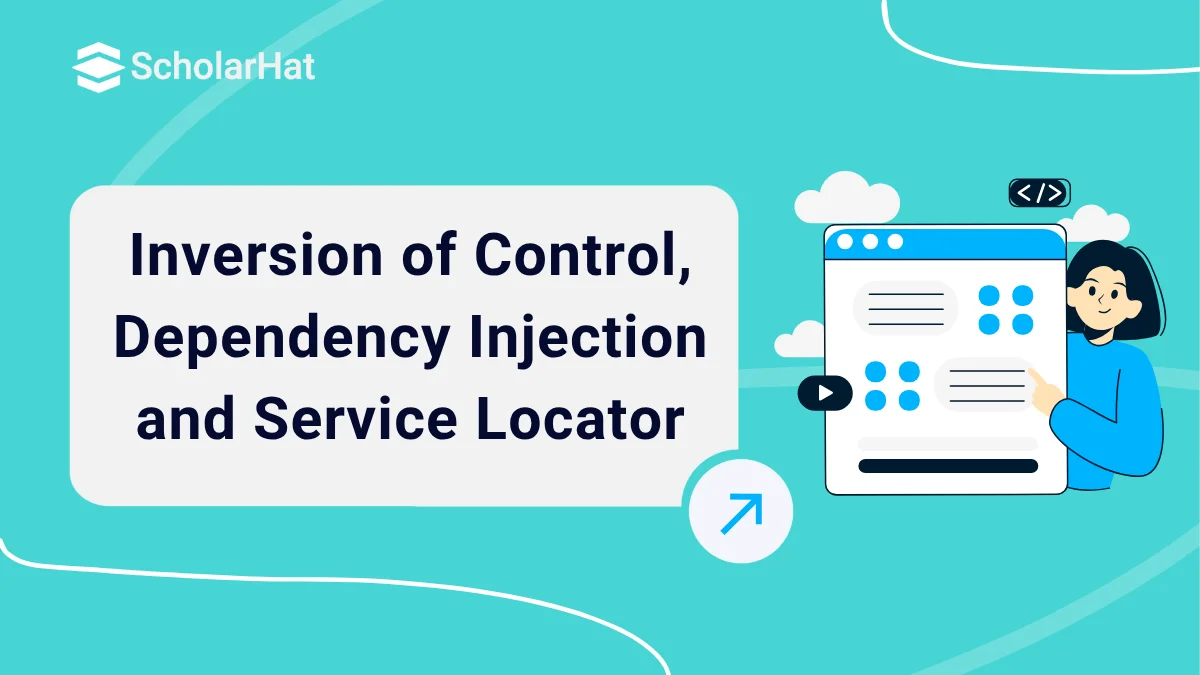08
JanUnderstanding Inversion of Control in C#
Inversion of Control
Inversion of Control (IoC), Dependency Injection (DI), and Service Locator design are three fundamental principles that help to create manageable and scalable applications in modern software development. IoC separates task execution from implementation, increasing flexibility. DI injects dependencies into objects, whereas the Service Locator design relies on a central registry to deliver them.
In this design pattern tutorial, we'll explore what is inversion control?, the benefits of IoC, dependency injection, types of dependency injection, Service locator, Dependency Injection vs. Service Locator, and many more. By 2026, 65% of enterprise tech stacks will rely on .NET Design Patterns. Stay ahead with our Free .NET Design Patterns Online Course!
What is Inversion of Control?
- Inversion of Control is a design approach that reverses a program's control flow compared to typical procedural programming.
- Instead of the application managing its flow, control is delegated to an external entity, usually a framework or container.
- This move enables component separation and responsibility delegation, resulting in more modular and maintainable code.
Key Benefits of IoC:
- Decoupling: Objects rely less on actual implementations and more on abstractions, making the system more modular.
- Ease of Testing: With dependencies injected, it is easier to replace genuine dependencies with mocks or stubs, enabling unit testing.
- Flexibility: Changes to system behavior or configurations can be made without altering the source code, which improves maintenance.
Dependency Injection (DI)
Dependency Injection (DI) is a design technique that uses IoC to pass (inject) dependencies into a class rather than having the class build them itself. This can be achieved in a variety of methods, including constructor, setter, and method injections.
Types of Dependency Injection (DI)
There are three types of dependency injection that are:
- Constructor Injection
- Setter Injection
- Method Injection
Let's understand each of them step by step:
1. Constructor Injection
- Dependencies are specified via a class constructor.
- Makes sure that the class cannot be created without its dependencies, hence increasing immutability.
Example
public class Service
{
private readonly IRepository _repository;
public Service(IRepository repository)
{
_repository = repository;
}
} | Read More: Extension Methods in C#: Types, Real-Time Examples |
2. Setter Injection:
- Dependencies are defined using public setter methods.
- Allows dependencies to be altered after object creation.
Example
public class Service
{
private IRepository _repository;
public IRepository Repository
{
set { _repository = value; }
}
}3. Method Injection
- Dependencies are specified via method parameters.
- Helpful in injecting dependencies that are only required for certain functions.
Example
public class Service
{
public void PerformOperation(IRepository repository)
{
// Use the repository
}
}Advantages of Dependency Injection
- Promotes Loose Coupling: By relying on abstractions rather than specific implementations, components become loosely connected.
- Improves Testability: Dependencies are readily imitated or stubbed for testing purposes.
- Improves maintainability: By eliminating the need to modify dependent classes when dependencies change.
Service Locator
Example
public interface IServiceLocator
{
T GetService();
}
public class ServiceLocator : IServiceLocator
{
private readonly IDictionary _services = new Dictionary();
public void RegisterService(T service)
{
_services[typeof(T)] = service;
}
public T GetService()
{
return (T)_services[typeof(T)];
}
} Advantages of the Service Locator:
- Centralized Configuration: All dependencies are controlled in one spot.
- Flexible: New services can be added to the locator without affecting the classes that use them.
Disadvantages of Service Locator
- Hidden Dependencies: Dependencies are not explicit in class interfaces, making the code more difficult to understand and maintain.
- Runtime Errors: If a service is not registered, it may generate runtime errors.
| Read More: What is IoC Container or DI Container? |
Comparison: Dependency Injection vs. Service Locator
| Dependency Injection (DI) | Service Locator |
| Dependencies are introduced into an item from the outside. | Dependencies are obtained from a centralized service locator. |
| Dependencies are explicitly defined and injected. | Dependencies are obtained implicitly from the locator. |
| The components are loosely coupled and independent of the DI container. | Tightly coupled to the service locator, which handles dependencies. |
| High testability: It is simple to create mocks or stubs. | Lower testability: It is more challenging to replace mocks or stubs. |
| Clear and explicit dependencies make programming more readable and maintainable. | Dependencies are less obvious, which complicates code comprehension and maintenance. |
| Components can be easily replaced or modified. | Centralized access might make dependency management easier, but it can also complicate things. |
| Frequently used with frameworks that enable automated lifecycle management. | Lifecycle management should be performed separately or within the locator. |
| It is possible to incur additional setup and configuration overhead. | Centralized management might result in a single point of failure or bottleneck. |
Summary
FAQs
Take our Designpatterns skill challenge to evaluate yourself!

In less than 5 minutes, with our skill challenge, you can identify your knowledge gaps and strengths in a given skill.










